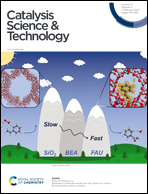An atomic insight into BiOBr/La2Ti2O7 p–n heterojunctions: interfacial charge transfer pathway and photocatalysis mechanism†
Abstract
Novel p–n heterojunction BiOBr/La2Ti2O7 nanocomposites were synthesized through a hydrothermal method and applied to photocatalytic NO removal. The reaction course of visible light photocatalytic NO removal was dynamically monitored by in situ FT-IR, and free radicals were captured by electron spin resonance (ESR). The reaction mechanism of photocatalytic NO oxidation on BiOBr/La2Ti2O7 was revealed. Density functional theory (DFT) calculations show that when BiOBr comes into contact with La2Ti2O7 to form a p–n heterojunction, the charge could transfer from the La atom of La2Ti2O7 to the O atom of BiOBr, leading to the accumulation of negative charge in the BiOBr region. When the Fermi levels of BiOBr and La2Ti2O7 are in equilibrium, an internal electric field (IEF) from La2Ti2O7 to BiOBr is established simultaneously. Under visible light illumination, the photogenerated electrons (e−) in the conduction band (CB) of BiOBr would migrate to the CB of La2Ti2O7 with the assistance of the IEF, and the holes (h+) are gathered on the valence band (VB) of BiOBr. With this IEF, the charge carrier separation on BiOBr/La2Ti2O7 was highly promoted and thus the visible light photocatalytic NO removal performance was enhanced. This work provides a new perspective on the understanding of the construction mechanism of p–n type heterostructures and the mechanism of gas–solid phase photocatalytic reactions.



 Please wait while we load your content...
Please wait while we load your content...